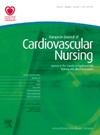在高级执业护士领导的社区胸痛综合门诊中,ESC 慢性冠状动脉综合征检测前概率评分是否有助于冠状动脉疾病的诊断?
IF 3.9
3区 医学
Q2 CARDIAC & CARDIOVASCULAR SYSTEMS
引用次数: 0
摘要
背景 高级执业护士 (ANP) 领导的综合社区胸痛门诊为全科医生转诊非急性胸痛患者提供了另一种途径,从而避免了急诊室的检查。助理护士的作用是区分非心绞痛和心绞痛的原因。除了询问临床病史、体格评估和心电图外,ANP 还利用 2019 年 ESC 指南中的慢性冠状动脉综合征预试验概率 (PTP) 评分来判断是否需要进行侵入性检查。目的 在社区诊所对胸痛进行 ANP 评估在爱尔兰医疗环境中是独一无二的。其目的是评估心绞痛特征和amp;分配的 ESC PTP 是否可预测社区胸痛队列中冠状动脉疾病(CAD)的诊断。方法 对在 ICCPC 接受 ANP 评估并随后转诊接受冠状动脉造影术的 144 名患者进行回顾性审核。最终诊断结果按 i. 冠状动脉特征、ii. ESC PTP、iii. 年龄和性别进行分析。质量、安全和风险管理部门对此进行了审批。结果 92 名男性患者和 51 名女性患者的平均年龄分别为 61 岁和 61 岁。在转诊接受血管造影检查的患者中,92%(132 人)确诊为冠状动脉疾病;38%(55 人)确诊为阻塞性冠状动脉疾病,54%(77 人)确诊为非阻塞性冠状动脉疾病(NOCAD)。31%(45 人)的 ANP 将心绞痛特征定为 "典型",58%(26 人)被诊断为阻塞性 CAD,平均 PTP 为 20%,38%(17 人)被诊断为 NOCAD。在有 "典型 "症状的病例中,只有两例冠状动脉正常。相反,34%(49 例)有 "非心绞痛 "症状,其中 28%(14 例)被诊断为阻塞性 CAD;由于年龄和临床可能性,12 例病例的 PTP 为中高值。大多数转诊病例(57%)的 CAD PTP 为 "高"(≤16%-52%),平均为 22%。确诊为 CAD 的患者的平均 PTP 为 27%(高),而冠状动脉正常的患者(12 人)的 PTP 为 11%(中)。14%的患者(20 人)被归入 "呼吸困难 "这一新类别,结果被诊断为非冠状动脉粥样硬化症(12 人)和冠状动脉硬化症(5 人)。以呼吸困难为主要症状的 CAD 患者均为男性,且 PTP 较高。结论 测试前概率与年龄高度相关,随着年龄的增长而上升,并由性别决定。主要变量是 ANP 指定的 "心绞痛 "特征。在这个以社区为基础的队列中,由 ANP 划分的 "典型 "症状导致较高的 PTP 和随后的 CAD 诊断。对 "中低风险 "的临床怀疑可通过临床似然比进一步调整。PTP 评分在预测 CAD 方面的价值与 "心绞痛 "特征和临床似然比一样有用,需要专业的健康史采集。这项对社区人群冠状动脉造影结果的回顾性分析证明,ANP 能够熟练地利用 ESC PTP 评分来协助诊断 CAD。本文章由计算机程序翻译,如有差异,请以英文原文为准。
Does the ESC chronic coronary syndrome pre-test probability score assist coronary artery disease diagnosis in an advanced nurse practitioner led integrated community chest pain clinic?
Background The Advanced Nurse Practitioner (ANP) led integrated community chest pain clinic provides an alternative avenue to which GPs can refer patients with non-acute chest pain providing emergency dept. avoidance. The role of the ANP is to differentiate between a non-anginal versus anginal cause. In addition to taking a clinical history, physical assessment and ECG the ANP utilises the 2019 ESC guidelines for chronic coronary syndromes pre-test-probability (PTP) score, to judge if invasive investigation is required. Purpose ANP assessment of chest pain in a community clinic is unique in the Irish healthcare setting. The aim was to assess if angina characteristics & allocated ESC PTP were predictive of coronary artery disease (CAD) diagnosis in a community chest pain cohort. Method A retrospective audit of 144 patients assessed by the ANP in the ICCPC and subsequently referred for coronary angiography was performed. Final diagnosis of was analysed by i. anginal characteristic, ii. ESC PTP, iii. age and sex. Approval was given by the department of quality, safety and risk management. Results The average combined age was 61 years in n=92 Male, and n=51 Female patients. Coronary Artery Disease was diagnosed in 92% (n= 132) of those referred for angiography; obstructive CAD in 38% (n=55) and non-obstructive CAD (NOCAD) in 54% (n=77). The ANP allocated the angina characteristic ‘typical’ in 31% (n=45) cases and 58% (n=26) were diagnosed with obstructive CAD, average PTP of 20%, and 38% (n=17) were diagnoses with NOCAD. In those with ‘typical’ symptoms only two cases resulted in normal coronary arteries. Conversely 34% (n=49) were allocated ‘non-anginal’ symptoms, in whom 28% (n=14) obstructive CAD was detected; 12 cases had an intermediate to high PTP due to age and clinical likelihood. The majority of referrals (57%) were ‘high’ PTP of CAD (≤16%-52%), average 22%. The average PTP was 27% (High) in those diagnosed with CAD versus a PTP of 11% (Intermediate) in those with normal coronaries (n=12). The new category of ‘dyspnoea’ was allocated to 14% (n=20) and resulted in diagnosis of NOCAD (n=12) and (n=5) CAD. Those with dyspnoea as a presenting symptom of CAD were all male with high PTP. Conclusion Pre-test-probability and age are highly correlated, rising with age and defined by sex. The main variable is the ‘angina’ characteristic allocated by the ANP. In this community-based cohort, ‘typical’ symptom allocation by the ANP resulted in a higher PTP and subsequent CAD diagnosis. Clinical suspicion in the ‘low-intermediate risk’ can be further adjusted using the clinical likelihood ratio. The value of the PTP score in predicting CAD is as useful as the ‘angina’ characteristic and clinical likelihood allocated, requiring expert health history taking. This retrospective analysis of coronary angiogram results in this community cohort evidences that the ANP is skilled in utilising the ESC PTP score to assist in the diagnosis of CAD.
求助全文
通过发布文献求助,成功后即可免费获取论文全文。
去求助
来源期刊

European Journal of Cardiovascular Nursing
CARDIAC & CARDIOVASCULAR SYSTEMS-NURSING
CiteScore
5.10
自引率
10.30%
发文量
247
审稿时长
6-12 weeks
期刊介绍:
The peer-reviewed journal of the European Society of Cardiology’s Council on Cardiovascular Nursing and Allied Professions (CCNAP) covering the broad field of cardiovascular nursing including chronic and acute care, cardiac rehabilitation, primary and secondary prevention, heart failure, acute coronary syndromes, interventional cardiology, cardiac care, and vascular nursing.
 求助内容:
求助内容: 应助结果提醒方式:
应助结果提醒方式:


